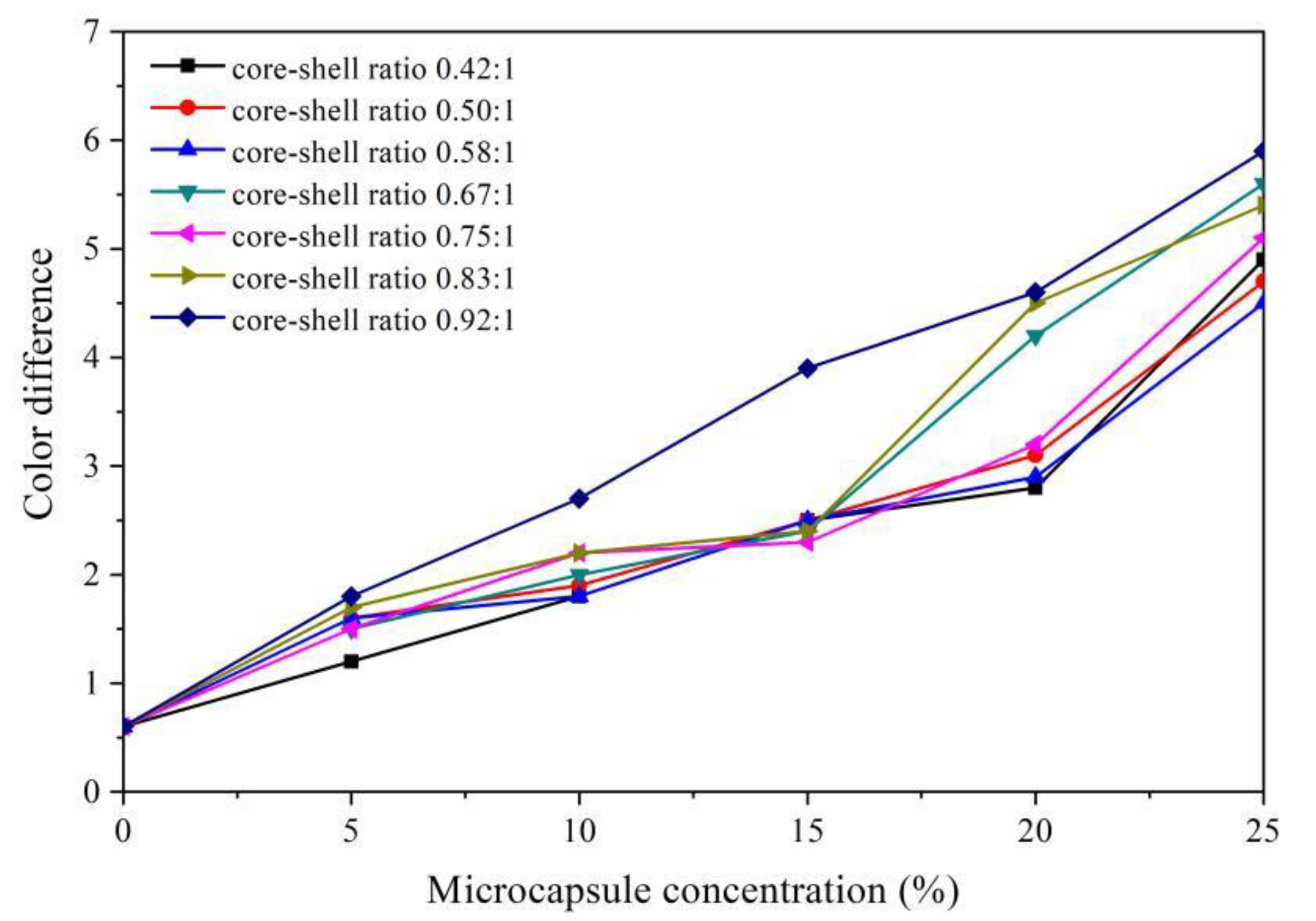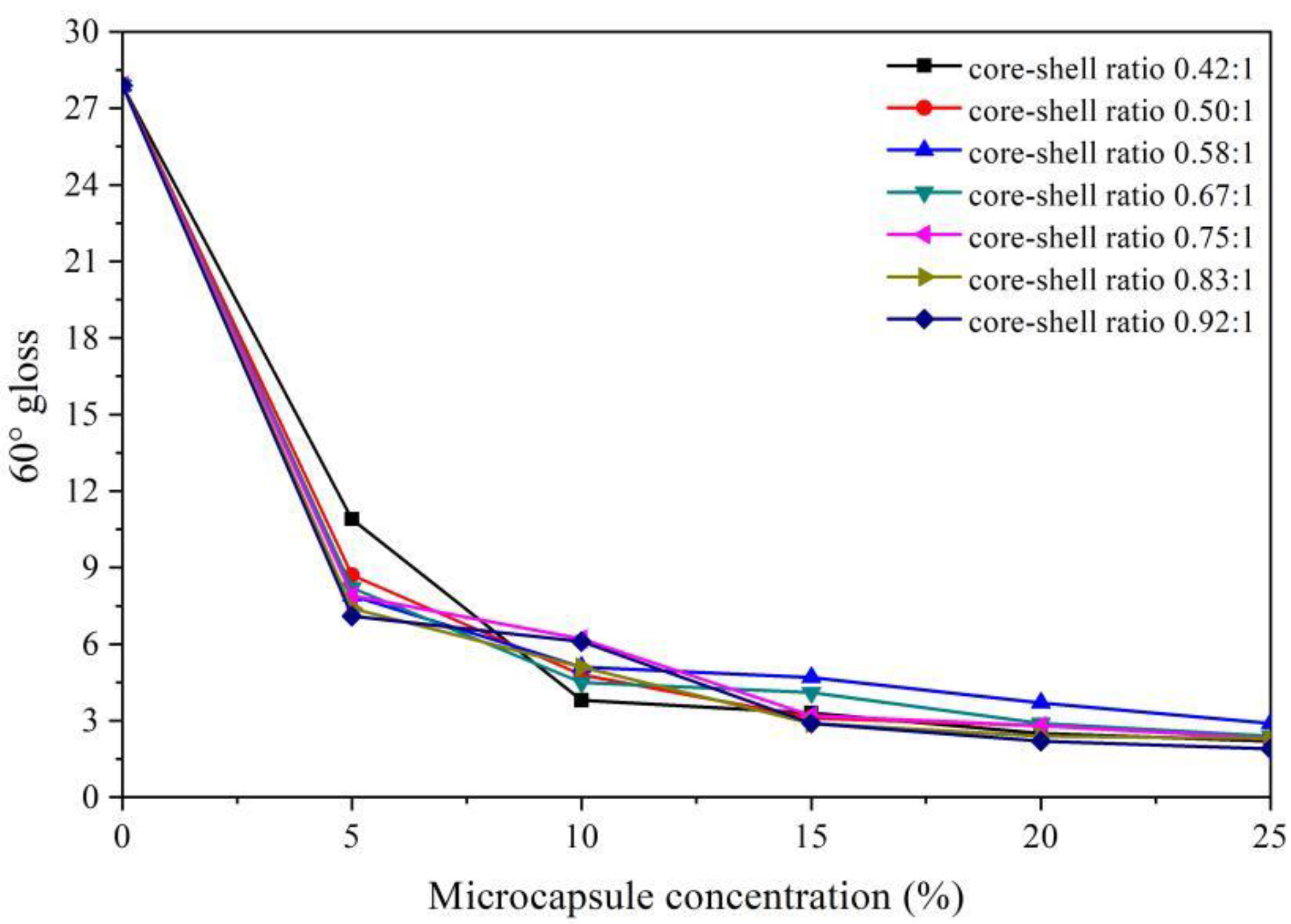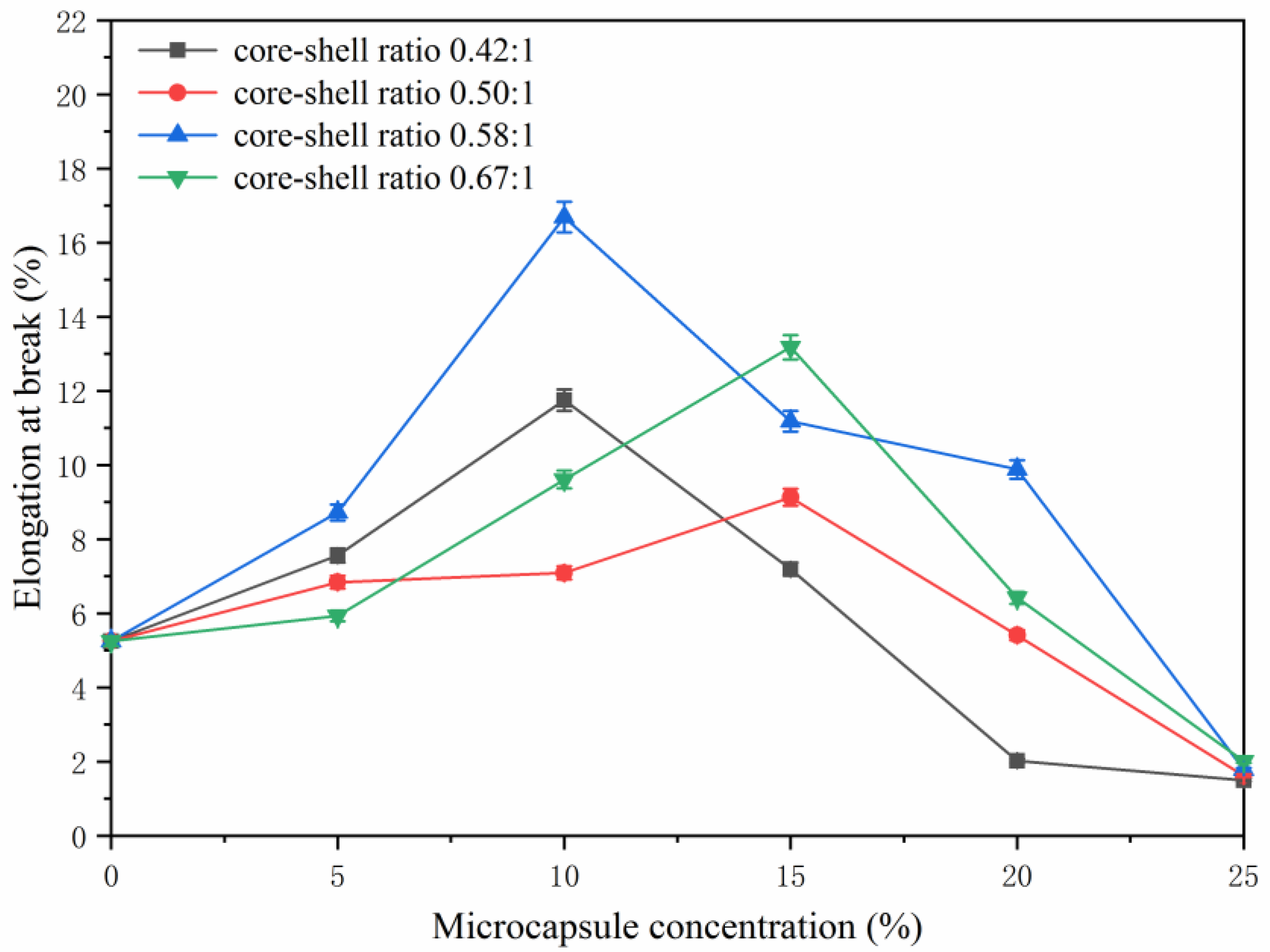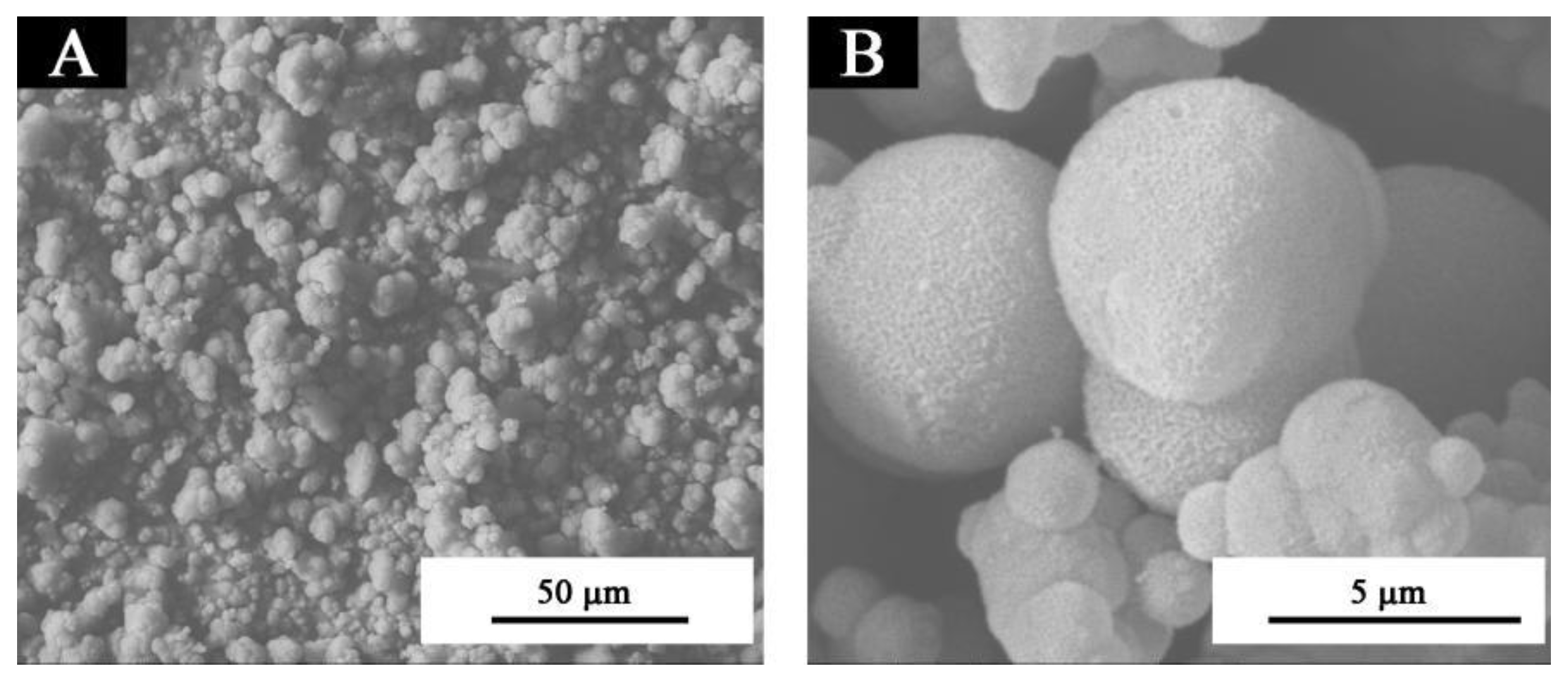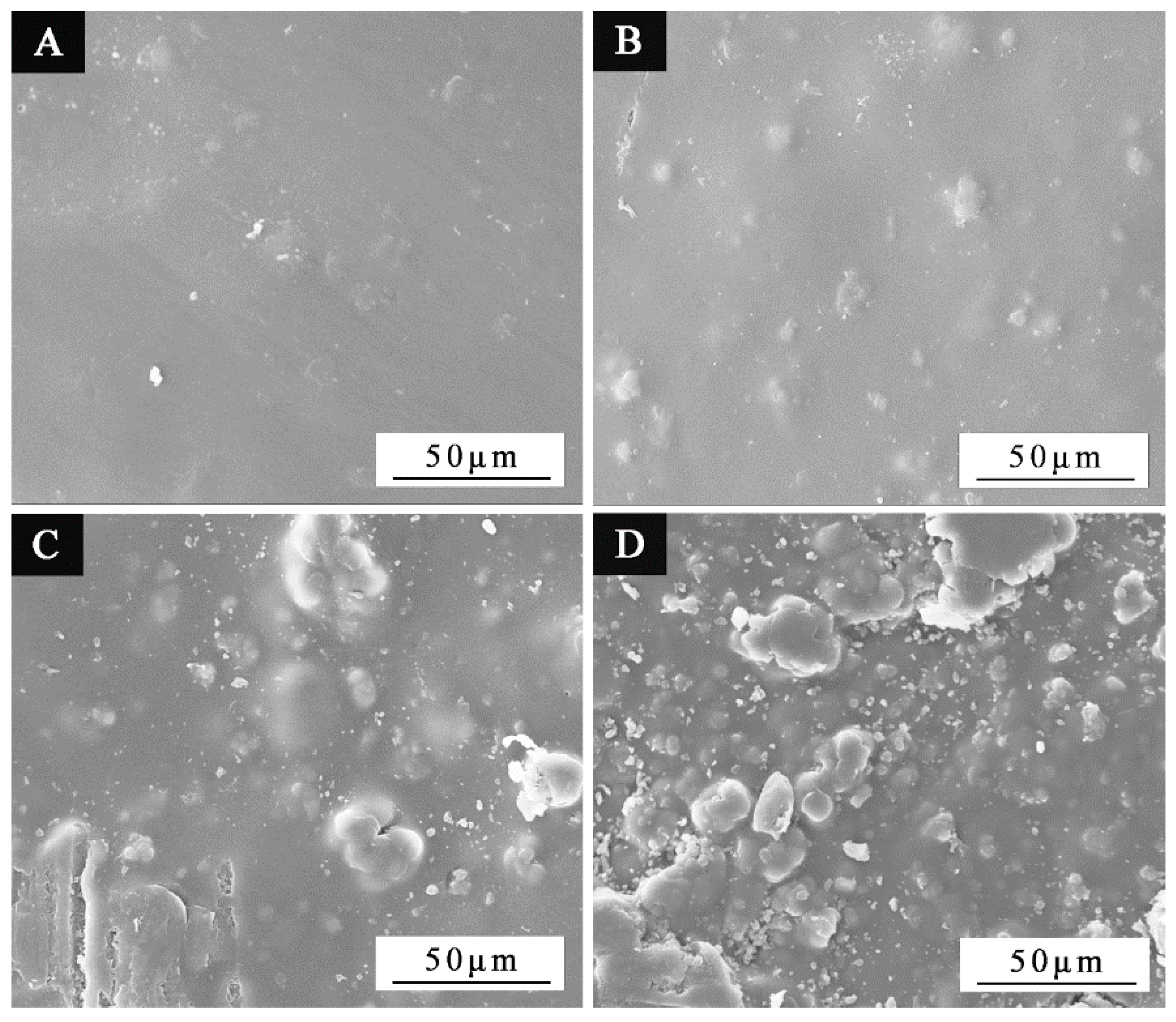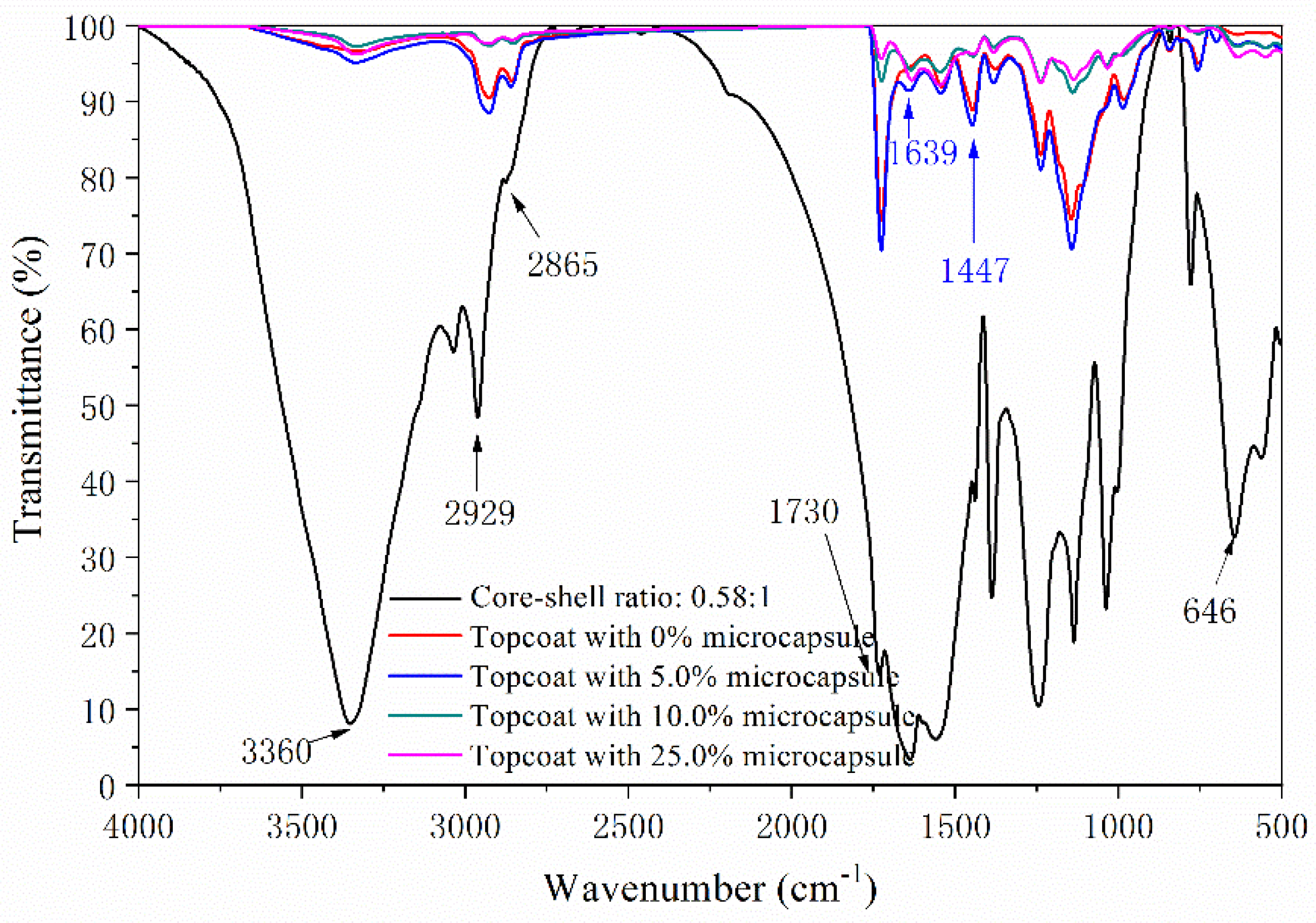1. Introduction
As a natural polymer composite material, wood material has unique texture and color [
1]. It is a common green resource in nature [
2]. As environmental awareness is growing, wood materials have become the preferred object of use because of their high strength to weight ratio, low energy consumption, natural degradation and recyclable utilization, and they are widely used in construction, indoor, packaging, railway transportation (as hardwood sleepers) and other production activities [
3,
4]. However, the cellulose, the main component of such kind of materials, contains many hydrophilic groups, which leads to its wet expansion and the drying of the wood, with a size variation which limits its application scopes and further affects its service life [
5,
6,
7,
8]. In general, wood materials are subjected to surface treatments before being put into actual use [
9,
10,
11,
12,
13]. The rheology and stabilizers are very important for the properties of coatings [
14]. Waterborne wood coatings are very popular in wood surface finishing because of their advantages regarding environmental protection, pollution resistance and fast drying [
15]. However, there are also some disadvantages, such as easy aging and microcracks in daily use, which impinge on the beauty and service life of these products [
16].
The service life of paint film can be prolonged by embedding a repair agent in the coating [
17,
18]. This specific implementation includes a liquid core fiber method and a microcapsule method [
19]. Based on the application of microcapsule technology in composite materials, some progress has been made. Litina et al. [
20] first applied the polymer microcapsules, including liquid sodium silicate, to the self-repair of industrial repair mortar, and the best self-healing additives were selected. Accordingly, it turned out that both the crack width and depth of the new composite cement-based repair material were reduced, and the permeability was restored. Njoku et al. [
21] fabricated a novel pH-responsive permeability-switching polyurea-formaldehyde-coated 8-hydroxyquinoline microcapsule, which was used to prepare intelligent epoxy film for the permanent protection of Al-based alloys. The results indicated that the modified epoxy-based smart film has a good barrier and is active in improving the self-healing and corrosion inhibition performances. Wang et al. [
22] synthesized fluorescent-labeled self-healing microcapsules (FLSM) by ultrasonic dispersion in-situ polymerization. Fluorescein sodium-labeled epoxy resin served as the restorative agent and UF resin as the cladding material. The results confirmed that FLSM can detect the position of microcracks and repair them and also indicates the width of microcracks on the cement surface. The above studies showed that the internal and external damage of the matrix material could be automatically repaired by mimicking the self-healing function of organisms and the participation of external environmental factors, to prolong the service life of the material. But it is worth noting that these studies focused on readily available commercial repair mortars, Al alloys and cement paste, and there are few reviews on the self-healing of waterborne wood paint films.
In our early work, epoxy resins laden with UF microcapsules were fabricated, and the effects of microcapsules and the coating process on gloss, color difference and the toughness of waterborne paint films for F. mandshurica veneers were studied [
23]. As a common wood material,
Tilia europaea has moderate hardness and a uniform and fine texture [
24]. It is easy to process and possesses strong toughness, good corrosion resistance, wear resistance and resistance to crack deformation [
25]. Nowadays, the demands of waterborne film-forming wood coatings are more and more extensive, so there is a need for a variety of wood substrates to meet the public aesthetic and to create application opportunities for self-healing wood products in a smart manner. Epoxy resin as a restorative agent needs to contain a hardener or a crosslinking agent and to be heated to achieve curing, which is not realistic for wood products, especially for furniture and floor products. Generally speaking, a waterborne primer is mainly used to fill pores and improve film thickness. On the other hand, the main function of a topcoat is to play the role of decoration and protection, such as keeping light and color, improving hardness and adhesion and leveling. Primer and topcoat have different functions, and their performances may be different. In this respect, the effect of microcapsules with different core-shell ratios on the performance of a waterborne primer for
Tilia europaea was recently investigated [
26]. Therefore, it is necessary to explore the presence of microcapsules on the properties of a waterborne topcoat on wood.
In this work, the safe and non-toxic water-based acrylic resin was used as the core material, and the hard and dense UF resin was used as the shell material to prepare microcapsules with seven different core-shell ratios. The microcapsules were added to the waterborne topcoat and spread on the Tilia europaea substrate to study the effect of the core-shell ratio and also the content of the microcapsules on the performance of the waterborne paint film. The waterborne acrylic resin with the same material as the paint base is selected as the core material to explore the effects of the addition of microcapsules on the optical properties, mechanical properties and liquid resistance of the waterborne topcoat. The repair agent can be cured at room temperature without introducing other media, which is conducive to interface bonding. In the future, the goal is to improve the repair rate of microcapsules. The results so obtained may serve as useful prerequisites in the preparation of self-healing waterborne wood coatings.
2. Materials and Methods
2.1. Experimental Materials
The materials required for the experiment are displayed in
Table 1. The
Tilia europaea with the size of 90 mm × 45 mm × 4 mm has been processed until its surface color was uniform, and its moisture content reached the local equilibrium, respectively 14.9%. The main components of waterborne topcoat were waterborne acrylic emulsion, polyurethane emulsion, additives and water.
2.2. Preparation of Microcapsules
Microcapsules with waterborne acrylic resin as the core material and UF resin as the shell material were prepared by in situ polymerization with the following values of the core-shell ratio as an independent variable: 0.42:1, 0.50:1, 0.58:1, 0.67:1, 0.75:1, 0.83:1 and 0.92:1 [
27]. This paper mainly studied the effects of the core-shell ratio and the concentration of microcapsules on the properties of paint film. In later work, the stabilizer will be used to modify the microcapsules. The detailed compositions of the seven systems are shown in
Table 2. To exemplify, the preparation process of microcapsules with a core-shell ratio of 0.42:1 was as follows:
The 40.0 g of urea and 54.0 g of formaldehyde solution were uniformly stirred with a magnetic stirrer. A corresponding amount of triethanolamine was added to adjust the pH to 8.0. The shell material was obtained after stirring the mixture for 70 min at 350 rpm and at a constant temperature of 75 °C. The emulsion of the core material was obtained by adding 25.0 g of waterborne acrylic resin into a mixture made of 1.8 g of sodium dodecyl benzene sulfonate (SDBS) and 193.0 g of distilled water (well-stirred previously) under vigorous stirring (1200 rpm) for 35 min at 60 °C. Then, the shell material solution was added into the core material emulsion, and the pH was adjusted to 2.0 by adding CAM under a stirring speed of 300 rpm for 2.5 h at 65 °C. The reaction mixture was kept at rest for 2 days at room temperature and then filtered, washed and dried to obtain the waterborne acrylic resin microcapsules with a core-shell ratio of 0.42:1.
2.3. Preparation of Waterborne Coatings
Seven types of microcapsules with different core-shell ratios (0.42:1, 0.50:1, 0.58:1, 0.67:1, 0.75:1, 0.83:1, 0.92:1) were prepared. Six kinds of coating films were prepared for each type of microcapsule. The mass fraction of microcapsules in the paint films was 0%, 5.0%, 10.0%, 15.0%, 20.0% and 25.0%, respectively. The materials required for the preparation of different core-shell ratio paint films are collected in
Table 3. The microcapsules and waterborne coatings were mixed evenly and then spread on
Tilia europaea substrate with a ZBQ tetrahedral preparator (Pushen Chemical Machinery Co., Ltd., Shanghai, China). Then the
Tilia europaea, coated with water-based paint, was dried in a ventilated place for 25 min, then lightly polished with sandpaper until the paint film surface was smooth [
28]. The above steps were repeated twice to obtain the paint film samples of about 60.0 microns thick required for further testing.
2.4. Testing and Characterization
The gloss of the paint film at 60° was tested by the WG-60G glossmeter (Shenzhen Baoan Sannuo Instrument Supplier, Shenzhen, China); the color difference of the paint film was tested by the WR-10 portable colorimeter (Shenzhen Baoan Sannuo Instrument Supplier, Shenzhen, China), and the chromaticity values of two points on the paint film were comparatively assessed. The chromaticity values of one point on the paint film were denoted as
L1,
a1,
b1,
c1 and
H1, and the chromaticity values of the second point were denoted as
L2,
a2,
b2,
c2 and
H2 [
29]. The color difference (ΔE) was calculated according to
The hardness of paint films was tested by QHQ pencil hardness tester (Shenzhen Baoan Sannuo Instrument Supplier, Shenzhen, China), according to the hardness sequence of 6B-6H. The tip of the pencil was ground flat; the paint film was fixed on the stage, and the pencil was inserted into the hardness tester, so that the pencil abutted on the paint film. The pencil hardness tester was moved slowly to observe the marks left behind by the pencil on the paint film. The hardness of the pencil with no scratching signs on the tested surface was considered the hardness of paint film.
The adhesive force was measured by a BYK cross-cut tester (Shenzhen Baoan Sannuo Instrument Supplier, Shenzhen, China). The paint film was drawn horizontally and vertically at the same place with the cross-cut tester, then pasted with adhesive tape. The adhesive force of the paint film was measured according to the peeling area of the paint film.
The impact resistance was tested by a QCJ-120 film impactor (Shenzhen Baoan Sannuo Instrument Supplier, Shenzhen, China). The paint film was placed at the bottom of the impactor, and the impactor impacted the paint film from progressively increasing heights. The height of the impactor at which microcracks appeared on the surface was considered the impact resistance of the paint film.
Sodium chloride, alcohol, detergent and red ink were used to test the liquid resistance of the paint film [
30]. A filter paper soaked with these liquids taken individually was placed on the surface of the paint film and covered with a glass slide. One day later, the filter paper was removed, and the residual reagents on the surface of the paint film were wiped off. The change of the paint film was taken into account, and the color difference and gloss in the tested area were evaluated. According to the pollution of the paint film surface, the liquid resistance grade of paint film was determined, and the effects of these four solutions on paint film were compared. Liquid resistance grade 1 indicated that there was no obvious change on the surface of the paint film. Grade 2 indicated that there was slight discoloration or discontinuous marks on the surface of the paint film. Grade 3 indicated that there were obvious marks on the surface of the paint film. Grade 4 indicated that there were serious marks on the surface of the paint film, but the structure of the paint film had not been changed. Grade 5 indicated that the paint film was broken and the structure of the paint film was changed.
The surface morphology of prepared microcapsules and paint films was investigated by an EVO18 scanning electron microscope (Changzhou Jonah Electromechanical Technology Co., Ltd., Changzhou, China), while the chemical composition of the paint film was studied by a BFH-960 Fourier transform spectrometer (Guangzhou Biaoji Packaging Equipment Co., Ltd., Guangzhou, China). All the experiments were carried out four times, and the experimental error was within 5.0%.
4. Conclusions
The UF-coated waterborne acrylic resin microcapsule with the different core-shell ratios and the same concentration had little effect on the overall color difference and gloss of the paint film. When the core-shell ratio was 0.58:1–0.67:1 and the microcapsule concentration was 10.0–15.0%, the hardness of the paint films was 2H–4H and the impact resistance was 12.0–15.0 kg·cm. The adhesion of the paint films was high at the core-shell ratio of 0.42:1–0.67:1. When the core-shell ratio of microcapsules was 0.58:1 and the microcapsule concentration was 10.0%, the color difference of the paint film was 1.8, the gloss was 5.1, the hardness was 2H, the adhesion was grade 1, the impact resistance was 15.0 kg·cm, the elongation at break of the paint film was 16.7%, and the resistance to NaCl, ethanol and detergent was grade 1; at this time, the comprehensive performance of waterborne paint film on Tilia europaea surface was better. The results provided the technical assistance for the development of self-healing waterborne wood coatings.
